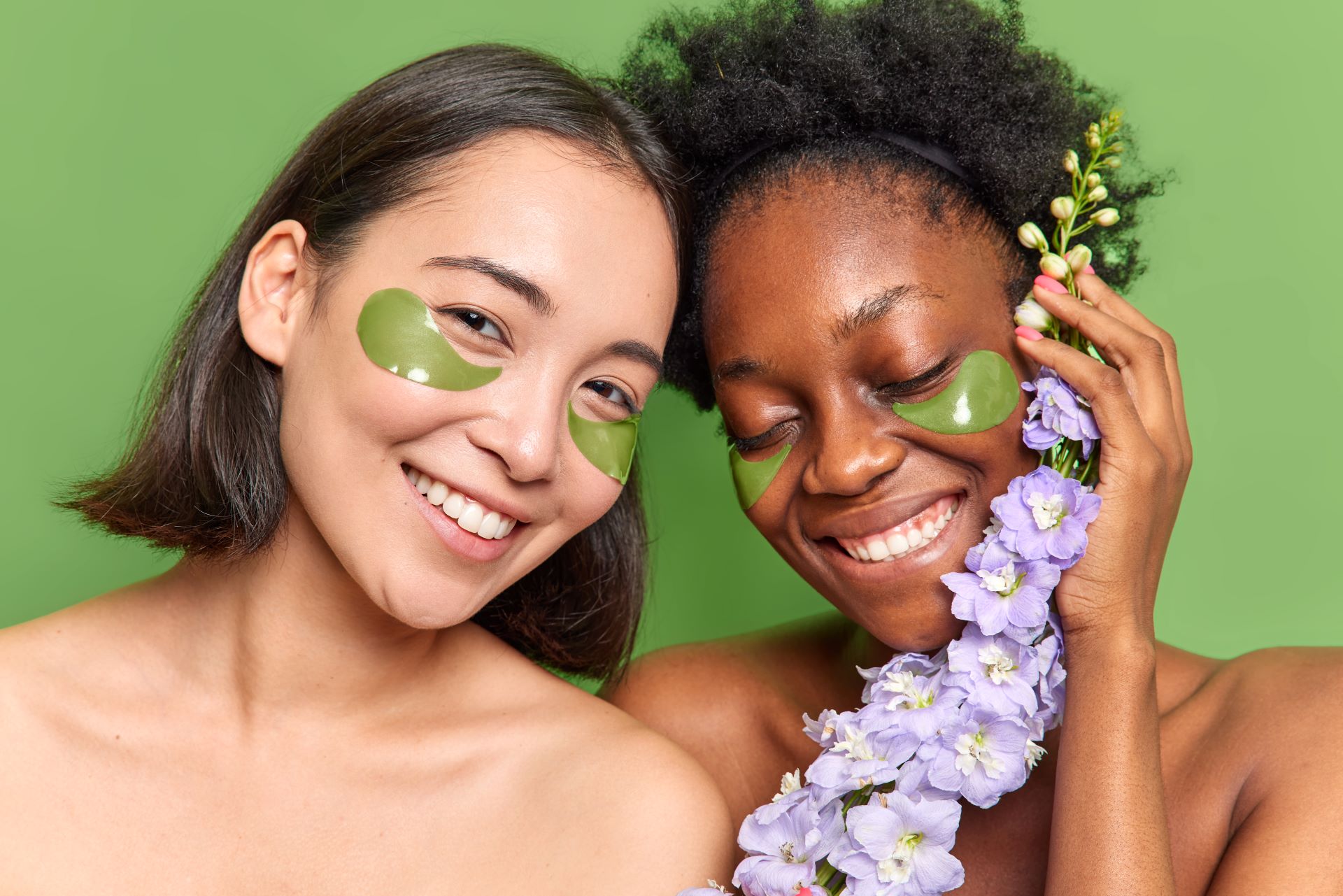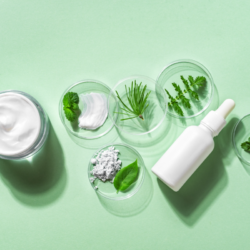Dark circles under the eyes reflect a number of factors: fatigue, heredity, diet and lifestyle. This article sheds light on their origins and offers preventive solutions for brighter, more rested-looking eyes. Dive into the world of periocular skin care and discover how to effectively reduce the appearance of dark circles.
Learn more about dark circles so you can act more effectively
Over and above fatigue, dark circles often reflect various intrinsic and extrinsic factors linked to our lifestyle and environment. Diet has a considerable impact on the health of our skin. An unbalanced diet rich in salt encourages water retention, which can lead to puffiness under the eyes and accentuate the appearance of dark circles. In addition, a lack of certain nutrients, such as iron or vitamin K, can contribute to darkening of the under-eye area.
Stress, for its part, is a significant aggravating factor. It causes blood vessels to dilate, making the bluish tint caused by blood circulation under the thin skin of the eyelids more visible. What’s more, the oxidative stress generated by a busy lifestyle can accelerate skin ageing and contribute to the breakdown of collagen, reinforcing the deep, dark appearance of dark circles.
Exposure to the sun also deserves special attention. UV rays trigger the production of melanin, which can intensify skin pigmentation and, as a result, darken dark circles. So it’s vital to protect this delicate area with a sunscreen suitable for the eye contour area to prevent hyperpigmentation.
To combat dark circles, it’s essential to adopt a healthy skincare routine and lifestyle. Adequate hydration, sufficient sleep and reducing exposure to screens before bedtime are effective preventive measures. We also recommend eating a diet rich in antioxidants and vitamins, and engaging in relaxing activities to manage stress. Targeted treatments such as cucumber, cornflower or chamomile water and cold compresses can complement this approach by soothing and revitalising the eye area.
Give your face a boost with reference products
As dark circles are the result of a circulation problem, the solution is to boost blood and lymph flow under the eyes. Moisturising is also essential.
- OENOBIOL anti-puffiness & dark circles treatment is specially designed to give you radiant eyes thanks to its dual action: firming to smooth and draining to reduce puffiness and dark circles. This treatment is ideal for people with visible dark circles and puffiness.
- Avril Eye Contour Care provides complete hydration, elasticity and soothing to the skin around the eyes. Wrinkles are smoothed away, and you’ll look better with radiant skin. This organic eye contour treatment has a soft, fast-absorbing texture.
- CeraVe Eye Contour Face Cream restores the protective barrier around the eyes thanks to its hyaluronic acid, niacinamide and essential ceramides components. This repairing eye cream has been meticulously developed with dermatologists to ensure optimum effectiveness.
- Avene Physiolift Eyes Wrinkles Puffiness Dark Circles: With the help of its patented anti-ageing active ingredients, this Avene anti-ageing treatment reduces existing wrinkles around the eyes. It also has a decongestant action to reduce puffiness and persistent dark circles. The result is firmer skin, dark circles halved and wrinkles smoothed.
How can I avoid getting dark circles?
To prevent the appearance of dark circles, we need to pay particular attention to our daily habits. Here are a few practical tips to keep your eyes looking fresh:
- Prioritise Quality Sleep: Lack of sleep can accentuate dark circles and puffiness under the eyes. Make sure you sleep between 7 and 9 hours every night in an environment that’s conducive to rest: darkness, silence and a pleasant room temperature. The sleep cycle has a direct influence on the appearance of the skin under the eyes, an area where blood vessels are particularly visible.
- Reduce exposure to blue light: Screens emit blue light, which is potentially harmful to the eyes and the circadian rhythm. Prolonged use of screens, especially before bedtime, can disrupt sleep quality. Glasses with blue-light filters can help to reduce eye fatigue and maintain a healthy night’s sleep, thereby helping to reduce the appearance of dark circles under the eyes.
- Eat a balanced diet: A diet rich in antioxidants, vitamins (C and K) and minerals such as iron is essential. These nutrients help strengthen blood vessels and reduce inflammation, which can help reduce the appearance of dark circles. Remember to include fresh fruit and vegetables, lean proteins and whole grains in your diet.
- Stay hydrated: Hydration is crucial to maintaining skin elasticity and avoiding dryness, which can exacerbate the appearance of dark circles. Drink at least 1.5 litres of water a day and use specific moisturisers for the eye area.
- Get regular exercise: Exercise promotes blood circulation and helps reduce stress, a factor known to aggravate dark circles. Find an activity you enjoy and make it part of your weekly routine.
- Manage your stress: Relaxation techniques, meditation, yoga or any other calming activity can help reduce stress. Effective stress management will have a positive impact on the quality of your skin.
- Protect Your Eyes From The Sun: Excessive sun exposure can aggravate dark circles by stimulating melanin production. Use wide-brimmed sunglasses and a specific sunscreen for the eye area when outdoors.
By following these tips, you can not only reduce existing dark circles, but also prevent them from developing in the future. A healthy lifestyle is your best ally in keeping your eyes bright and rested.
New prospects for the treatment of dark circles in 2024
Dark circles under the eyes are a global aesthetic concern. They have many causes, and their treatment requires a diversified, personalised approach. A number of recent studies have provided new insights into effective treatments for dark circles.
Heredity and physiological factors
Research in Brazil has shown that dark circles are often a hereditary trait, generally appearing around the age of 24, with increased severity for those who develop them earlier in life. The study also found a significant link between dark circles and asthma, but not with self-reported allergies. This suggests that certain factors linked to heredity and general health may play a more critical role in the appearance of dark circles than previously thought (PMID: 26375218).
Multi-corrective topical treatment
A topical eye cream treatment has been developed combining active ingredients such as vitamin C, peptides and plant extracts. This cream has been evaluated on a large population including different skin types and subjects from various ethnic backgrounds, showing promising results in improving the appearance of dark circles and puffiness under the eyes. Participants reported significant improvement, demonstrating that this cream could be an effective and well-tolerated treatment option (PMID: 38112168).
Autologous fat transfer vs platelet-rich plasma
A comparative study evaluated two aesthetic treatments to reduce dark circles: platelet-rich plasma (PRP) and nanofat-enriched autologous fat transfer. It was found that nanofat-enriched autologous fat transfer was significantly more effective than PRP with greater patient satisfaction. This result suggests that approaches using substances derived from the patient’s own body may have a greater impact on dark circle reduction and overall treatment satisfaction (PMID: 36735798).
Nanofat is a refined form of body fat, obtained by emulsifying and filtering autologous fat (taken from the patient). This technique produces a fine substance, rich in stem cells, which is used for its skin-regenerating properties and is particularly suitable for sensitive areas such as the eye contour. Nanofat is therefore used not to add volume, but to improve skin quality, notably by reducing pigmentation and increasing elasticity.
PRP, or Platelet Rich Plasma, is another aesthetic treatment technique that uses the patient’s own blood. The blood is centrifuged to extract plasma enriched with platelets, known for their high concentration of growth factors. These factors stimulate cell regeneration and tissue healing, making PRP effective in treating skin problems such as dark circles, scars and wrinkles.
These advances underline the importance of a personalised assessment by professionals to choose the most appropriate treatment. They also illustrate the scientific community’s ongoing commitment to understanding and treating this common aesthetic concern.
For an effective approach to dark circles, it is advisable to consult a dermatologist or skin care professional who can recommend the most suitable treatment, whether this involves topical solutions or advanced aesthetic procedures.
References
- https://www.ncbi.nlm.nih.gov/pmc/articles/PMC4560538/
- https://pubmed.ncbi.nlm.nih.gov/38112168/
- https://pubmed.ncbi.nlm.nih.gov/36735798/







